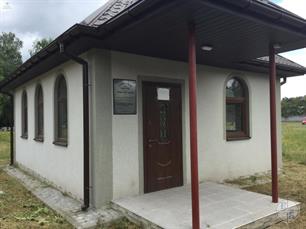Radyvyliv
Dubno district, Rivne region
Sources:
- Memorial Book of Radzivilov. Ed. Ya'acov Adini, Tel Aviv: Organization of Radzivilov Emigrants in Israel, 1966. Translated by JewishGen;
- Russian Jewish encyclopedia. Translated from Russian by Eugene Snaider;
- Yad Vashem. Radziwillow;
- The All South-Western Territory: reference and address book of the Kyiv, Podolsk and Volyn provinces. Printing house L.M. Fish and P.E. Wolfson, 1913
Photo:
- Memorial Book of Radzivilov
- Moisey Akymovych Ginsburg. His life and activity. With a foreword by H. B. Sliozberg. Edition of the circle of friends of M. A. Ginsburg. Paris, 1933
- Sergey Kravtsov, The Center for Jewish Art. Former Great Synagogue in Radyvyliv
- European Jewish Cemeteries Initiative. Radyvyliv New Jewish Cemetery;
- Zastavki, Wikipedia. Memorial at the place of destruction of the Jewish population of Radyvyliv
- Memorial Book of Radzivilov. Ed. Ya'acov Adini, Tel Aviv: Organization of Radzivilov Emigrants in Israel, 1966. Translated by JewishGen;
- Russian Jewish encyclopedia. Translated from Russian by Eugene Snaider;
- Yad Vashem. Radziwillow;
- The All South-Western Territory: reference and address book of the Kyiv, Podolsk and Volyn provinces. Printing house L.M. Fish and P.E. Wolfson, 1913
Photo:
- Memorial Book of Radzivilov
- Moisey Akymovych Ginsburg. His life and activity. With a foreword by H. B. Sliozberg. Edition of the circle of friends of M. A. Ginsburg. Paris, 1933
- Sergey Kravtsov, The Center for Jewish Art. Former Great Synagogue in Radyvyliv
- European Jewish Cemeteries Initiative. Radyvyliv New Jewish Cemetery;
- Zastavki, Wikipedia. Memorial at the place of destruction of the Jewish population of Radyvyliv
Radyvyliv, or Radzivilov (in 1939–94 - Chervonoarmeysk), city (from 1940), until 2020 - the district center in the Rivne region.
Known from 1564. In the 16-18 centuries - in the Kremenets powiat of Volyn Voivodeship as part of the Commonwealth. Since 1793 - as part of the Russian Empire. In the 19th - beginning of the 20th century - the township Radzivilov of Kremenets district of the Volyn province. In 1919–39 - in the Volyn Voivodeship as part of Poland, in 1939–91 - as part of the Ukrainian SSR.
In 1765, 298 Jews lived in Radyvyliv,
in 1847 - 3054,
in 1870 - 2263 (79%),
in 1888 - approx. 3700 (c. 50%),
in 1897 - 4322 (59.1%),
in 1910 - 8276 (56.6%),
in 1921 - 2036 (48%),
in 1931 - 2970 (55%),
In 1937 - 3120 Jews (52%).
The town's name points to the fact that its beginning was connected to the Prince of Radzivil's family, but it is not known when or by whom the town was founded.
The proximity of Brody hampered Radzivilov's growth. It is known that Ignacy Malchevsky was the town's owner in 1775, and Miyonchinsky inherited the town afterward. General Gaetan Miyonchinsky, a member of this family, obtained a permit to establish a printing house for Hebrew and Yiddish books on February 19, 1787.
During General Miyonchinsky's lifetime, the town owed the Warsaw banker Shults considerable sums, and after the town became his, he did a great deal to further its growth. When he owned the town, the renowned tannery was founded by Parisot, based on a permit from King Stanislaw August dated July 24, 1789.
The ownership of the town passed from Shults to the nobleman Gorzhynski.
In 1775 there were 298 Jews in the town.
In 1772, when Brody was transferred to Austrian possession, the trade route, which until then had gone through Brody, went to Radzivilov for only a brief time, even though Poland made every effort to draw tradesmen from Brody to Radzivilov by giving them all kinds of incentives. Only after some time did the tradesmen of Brody begin to send large quantities of merchandise via Radzivilov. And so Yitschak Tishminitski and Moshe Danovits of Brody sent large quantities of salt from Brody via Radzivilov, and from there they brought crops to Brody that they sent to Germany. Also, Brody wholesalers Leyzer Bik and Fayvel Herts sent large quantities of salt to Lithuania via Radzivilov.
In 1787, a Jewish printing house opened in Radzivilov.
In 1788, some Jews from Brody, among them Duvid Asherovich, who was known as a lead, medical products, and graphite merchant, founded a gunpowder factory. It is not known how long this factory existed.
Known from 1564. In the 16-18 centuries - in the Kremenets powiat of Volyn Voivodeship as part of the Commonwealth. Since 1793 - as part of the Russian Empire. In the 19th - beginning of the 20th century - the township Radzivilov of Kremenets district of the Volyn province. In 1919–39 - in the Volyn Voivodeship as part of Poland, in 1939–91 - as part of the Ukrainian SSR.
In 1765, 298 Jews lived in Radyvyliv,
in 1847 - 3054,
in 1870 - 2263 (79%),
in 1888 - approx. 3700 (c. 50%),
in 1897 - 4322 (59.1%),
in 1910 - 8276 (56.6%),
in 1921 - 2036 (48%),
in 1931 - 2970 (55%),
In 1937 - 3120 Jews (52%).
The town's name points to the fact that its beginning was connected to the Prince of Radzivil's family, but it is not known when or by whom the town was founded.
The proximity of Brody hampered Radzivilov's growth. It is known that Ignacy Malchevsky was the town's owner in 1775, and Miyonchinsky inherited the town afterward. General Gaetan Miyonchinsky, a member of this family, obtained a permit to establish a printing house for Hebrew and Yiddish books on February 19, 1787.
During General Miyonchinsky's lifetime, the town owed the Warsaw banker Shults considerable sums, and after the town became his, he did a great deal to further its growth. When he owned the town, the renowned tannery was founded by Parisot, based on a permit from King Stanislaw August dated July 24, 1789.
The ownership of the town passed from Shults to the nobleman Gorzhynski.
In 1775 there were 298 Jews in the town.
In 1772, when Brody was transferred to Austrian possession, the trade route, which until then had gone through Brody, went to Radzivilov for only a brief time, even though Poland made every effort to draw tradesmen from Brody to Radzivilov by giving them all kinds of incentives. Only after some time did the tradesmen of Brody begin to send large quantities of merchandise via Radzivilov. And so Yitschak Tishminitski and Moshe Danovits of Brody sent large quantities of salt from Brody via Radzivilov, and from there they brought crops to Brody that they sent to Germany. Also, Brody wholesalers Leyzer Bik and Fayvel Herts sent large quantities of salt to Lithuania via Radzivilov.
In 1787, a Jewish printing house opened in Radzivilov.
In 1788, some Jews from Brody, among them Duvid Asherovich, who was known as a lead, medical products, and graphite merchant, founded a gunpowder factory. It is not known how long this factory existed.
At the beginning of 1819, the printer Yehonatan left the town, leaving his place open “for the famous, exalted rabbinic exalted person,” our teacher the rabbi Pinchas son of Asher Zelig Barats. He purchased typographic material for the printer in the town of Poritzk and then enriched it with various letters. With the help of expert workers, he completed the printing of five sections of Chok L'Yisrael during 1819. After completing this book, he published an expensive edition of The Kuzari and also a second section of Sifre with Zera Avraham's commentary.
Due to competition from printers in Slavuta, the printer had to stop working, and he sold the rights to publish the book Chok L'Yisrael to the printer R' Aharon son of Yone. He sold the typographic material to Rabbi Yakov Finkelman of Berdichev. In one of the two printing houses that existed in this town, a prayer book containing Hasidic prayers and intentions was printed under the supervision of Rabbi Avraham Yehoshue Heshil of Opatуw.
During the Polish rebellion of 1830–1831, General Dvernitski's army corps operated in the vicinity of Radzivilov, with the support of the Radzivilov Jews.
In the years 1832–1835, merchandise worth approximately 15,000 rubles passed through Radzivilov, which benefited from the free city of Brody, a commercial center.
In 1870, 1,077 houses and 2,864 residents were counted in the town, but the number of Jews among them is not known. By 1888, the number of residents had grown to approximately 7,400, half of whom were Jewish. In 1897, there were 7,313 residents, including 4,322 Jews.
In the middle of the 19th century, Josef Lerner was a rabbi in Radzivilov, then his son Leizer, since 1898 the son of Leizer, Isroel-Dovid, became the rabbi.
Since 1900, Haim Roitenberg was a rabbi in Radzivilov, from 1905 - Avrom Pinkus, then - Itshok Lerner (great-grandson of Yosef Lerner).
Due to competition from printers in Slavuta, the printer had to stop working, and he sold the rights to publish the book Chok L'Yisrael to the printer R' Aharon son of Yone. He sold the typographic material to Rabbi Yakov Finkelman of Berdichev. In one of the two printing houses that existed in this town, a prayer book containing Hasidic prayers and intentions was printed under the supervision of Rabbi Avraham Yehoshue Heshil of Opatуw.
During the Polish rebellion of 1830–1831, General Dvernitski's army corps operated in the vicinity of Radzivilov, with the support of the Radzivilov Jews.
In the years 1832–1835, merchandise worth approximately 15,000 rubles passed through Radzivilov, which benefited from the free city of Brody, a commercial center.
In 1870, 1,077 houses and 2,864 residents were counted in the town, but the number of Jews among them is not known. By 1888, the number of residents had grown to approximately 7,400, half of whom were Jewish. In 1897, there were 7,313 residents, including 4,322 Jews.
In the middle of the 19th century, Josef Lerner was a rabbi in Radzivilov, then his son Leizer, since 1898 the son of Leizer, Isroel-Dovid, became the rabbi.
Since 1900, Haim Roitenberg was a rabbi in Radzivilov, from 1905 - Avrom Pinkus, then - Itshok Lerner (great-grandson of Yosef Lerner).
Radzivilov was a border town, and in it there was a central customs house. In czarist Russia, there were six customs houses, and one of them was in Radzivilov. Because of its geographic location, it was a convenient place for foreign trade. Goods, in particular grain, chickens, eggs, and similar products, were sent from Russia to western lands in great quantities. Many wealthy Jews were involved in this type of export, and they prospered greatly. They not only exported goods, but they were also involved in importing all sorts of products and particularly manufactured goods. The town also supported many agencies that were devoted to trade and tax issues, and these compatibly employed many clerks.
Twice a day, from 10:00 to12:00 AM and from 6:00 to 8:00 PM, the railroad station would quake with a rumble of noise. Trains would come and go with the flow of riders. Many Jews were associated either directly or indirectly with this stream of activity, making their living this way.
In addition to the train station, there was also what was called the “small” border, with only a four–kilometer separation between Radzivilov and the Austrian border; and from there to Brody was another five kilometers. And so many Jews found they could earn a living there, too. Because the surrounding area was relatively small, travelers would engage in the free flow of trade, and this, too, was a good source of income.
Twice a day, from 10:00 to12:00 AM and from 6:00 to 8:00 PM, the railroad station would quake with a rumble of noise. Trains would come and go with the flow of riders. Many Jews were associated either directly or indirectly with this stream of activity, making their living this way.
In addition to the train station, there was also what was called the “small” border, with only a four–kilometer separation between Radzivilov and the Austrian border; and from there to Brody was another five kilometers. And so many Jews found they could earn a living there, too. Because the surrounding area was relatively small, travelers would engage in the free flow of trade, and this, too, was a good source of income.
With the outbreak of World War I in 1914, Cossacks from a border corps conducted searches among the Jews, and while they were at it, they robbed and looted everything in their way. They also beat and arrested Jews, and some Jewish families were exiled to Siberia.
The town, which went back and forth between the Russians and the Austrians several times, suffered during the war years. A large part of the town was destroyed, and only a few Jewish residents remained. It was easier for the Jews during the Austrian occupation. The occupation authorities let them choose a community leader. At that time, Mr. Zaks was chosen as the head.
After the World War I, when the town's refugees returned to their homes, the population of Radzivilov grew to about 12,000, of whom about two thirds were Jewish.
Radzivilov served for a long time as a gate of Jewish immigration from Czarist Russia to the larger world, primarily to the United States of America. Because of the pogroms of 1882–1883–storms in the Negev–and the pogroms of 1904–1907, the flow of emigration kept increasing, and many fled through the town across the border to continue on to their destinations. Many were also revolutionaries, liberal authors, and others who fled the persecution of the reactionary czarist government in their country.
The Jewish community always formed the majority of the residents of the town, and among them were families of distinguished lineage who were deeply rooted in the life of the place.
The local intelligentsia was nourished by the nearby big cities in both Russia and Galicia. Commerce was well developed, and most of it belonged to the Jews. The central customs house in the town served as a source of abundant income for many families, some of whom had great wealth.
In Radzivilov there were a few cheders where the children of Israel learned Hebrew and Jewish studies and two Jewish government schools: one for young boys and one for young girls, and also a progymnasium for girls. Some wealthy people used to send their children to study in Dubno, Kremenets, and Rovno.
Radzivilov also had an active political life. A Zionist Organization was established in the town at the beginning of the current century. It operated underground in the days of the czar, but from 1917 on, when the revolution broke out, the organization appeared in the open among the rest of the parties, which increased their activities in Jewish areas. Zionist activity continued to grow, primarily under Polish rule: movements and parties multiplied–Youth Guard, Freedom, the Revisionists, and many others appeared. A farm for training pioneers in agriculture was also established in town.
As part of the Zionist endeavor, the Tarbut School's establishment must be mentioned, in which instruction was totally in Hebrew from 1924 on. Many of its students received special training and immigrated to the Land.
There were also many important public institutions in town, such as a hospital and an invalid home, and 16 synagogues, including our glorious and grand Great Synagogue.
The town, which went back and forth between the Russians and the Austrians several times, suffered during the war years. A large part of the town was destroyed, and only a few Jewish residents remained. It was easier for the Jews during the Austrian occupation. The occupation authorities let them choose a community leader. At that time, Mr. Zaks was chosen as the head.
After the World War I, when the town's refugees returned to their homes, the population of Radzivilov grew to about 12,000, of whom about two thirds were Jewish.
Radzivilov served for a long time as a gate of Jewish immigration from Czarist Russia to the larger world, primarily to the United States of America. Because of the pogroms of 1882–1883–storms in the Negev–and the pogroms of 1904–1907, the flow of emigration kept increasing, and many fled through the town across the border to continue on to their destinations. Many were also revolutionaries, liberal authors, and others who fled the persecution of the reactionary czarist government in their country.
The Jewish community always formed the majority of the residents of the town, and among them were families of distinguished lineage who were deeply rooted in the life of the place.
The local intelligentsia was nourished by the nearby big cities in both Russia and Galicia. Commerce was well developed, and most of it belonged to the Jews. The central customs house in the town served as a source of abundant income for many families, some of whom had great wealth.
In Radzivilov there were a few cheders where the children of Israel learned Hebrew and Jewish studies and two Jewish government schools: one for young boys and one for young girls, and also a progymnasium for girls. Some wealthy people used to send their children to study in Dubno, Kremenets, and Rovno.
Radzivilov also had an active political life. A Zionist Organization was established in the town at the beginning of the current century. It operated underground in the days of the czar, but from 1917 on, when the revolution broke out, the organization appeared in the open among the rest of the parties, which increased their activities in Jewish areas. Zionist activity continued to grow, primarily under Polish rule: movements and parties multiplied–Youth Guard, Freedom, the Revisionists, and many others appeared. A farm for training pioneers in agriculture was also established in town.
As part of the Zionist endeavor, the Tarbut School's establishment must be mentioned, in which instruction was totally in Hebrew from 1924 on. Many of its students received special training and immigrated to the Land.
There were also many important public institutions in town, such as a hospital and an invalid home, and 16 synagogues, including our glorious and grand Great Synagogue.
In 1914 in Radzivilov there was a Jewish hospital. Jews were all 3 dentists, both midwives.
Jews owned all 5 warehouses of pharmacy products, both kerosene warehouses, the only cinema (L.Goldshtein), all 6 forest warehouses, the only technical office (Haim Boym), 2 taverns (the brothers Segal and Haya Gutman, Froim Gaizer), all 3 photo studies (Moyshe Geiman, Berko Zilberman, Lazar Landsberg), 5 expedition offices, approx. 120 shops (including 35 bacalemes, all 19 manufactory, all 3 books, all 4 meat).
The Jews owns the majority of enterprises in Radzivilov: both sawmills (Goldgart, Liberman & Soydel; Yakov Faifess), all 4 furniture factories (Zundel Zaks, Leyb Boym, Yosef Treyger, Y.Kon), a mill (Haim Boym), the only soap factory (Boym brothers), a brewed factory, a pearl button factory, the only candle factory (Goldgart, Liberman & Soydel), the only tobacco factory (Shlomo Barats), both printing houses (Leyb Bogomolnyy, Ioyzel Gasser).
One of the largest enterprises was the factory of pearl buttons, which was founded by the nephews of Moshe Ginsburg, the brothers Lazar and Akiva Mess. 150 workers worked at the factory.
Jews owned all 5 warehouses of pharmacy products, both kerosene warehouses, the only cinema (L.Goldshtein), all 6 forest warehouses, the only technical office (Haim Boym), 2 taverns (the brothers Segal and Haya Gutman, Froim Gaizer), all 3 photo studies (Moyshe Geiman, Berko Zilberman, Lazar Landsberg), 5 expedition offices, approx. 120 shops (including 35 bacalemes, all 19 manufactory, all 3 books, all 4 meat).
The Jews owns the majority of enterprises in Radzivilov: both sawmills (Goldgart, Liberman & Soydel; Yakov Faifess), all 4 furniture factories (Zundel Zaks, Leyb Boym, Yosef Treyger, Y.Kon), a mill (Haim Boym), the only soap factory (Boym brothers), a brewed factory, a pearl button factory, the only candle factory (Goldgart, Liberman & Soydel), the only tobacco factory (Shlomo Barats), both printing houses (Leyb Bogomolnyy, Ioyzel Gasser).
One of the largest enterprises was the factory of pearl buttons, which was founded by the nephews of Moshe Ginsburg, the brothers Lazar and Akiva Mess. 150 workers worked at the factory.
 |
 |
 |
| Jewish cemetery in Radzivilov, 1910s | State hospital, named after patronage Moshe Ginsburg | Jewish home for invalids in Radzivilov |
After September 17, 1939 with the arrival of the Red Army in the town, following the Ribbentrop-Molotov Pact, Radzivilov became part of the Soviet Ukraine. Shortly afterwards the town was renamed as Krasnoarmeysk. The Soviet rule put an end to the communal life. The Jewish organizations and institutions were disbanded and private businesses had been nationalized. Several wealthy families of the town, as well as some Jewish refugees from the German occupied parts of Poland who opted not to take Soviet citizenship, were exiled by the Soviet authorities to Gulag.
Germans captured Radzivilov on June 27, 1941. In the first days of the German occupation, some local Ukrainians and Germans robbed the Jews. On July 15, 1941 28 Jews were shot to death allegedly as Communist activists by an SS unit outside the town, in the forest near the East Galician border city of Brody.
The next day Ukrainian thugs organized the public burning of prayer books and Torah scrolls from the synagogue and forced the rabbi of the town, rabbi Itzchak Lerner to dance around the bonfire.
On August 15, the Jewish committee, that had been set up immediately after the German occupation, became a Judenrat (Jewish council). The committee head, Weiderhorn, an assimilated German-speaking Jew from Hungary resigned and Jacob Furman took over as a new chairman of the Judenrat.
On August 25 the Jews of the town were ordered to wait in the market square for several hours, during this time their houses were looted of all valuable possessions.
In the summer and fall of 1941 the Germans implemented a series of anti-Jewish measures in Radzivilov. The Jews were ordered to wear distinctive markings (initially white armbands with a blue Star of David, replaced in December by yellow circles on their chest and backs); they were prohibited from leaving the town without permission, from using the sidewalks, or from trading with the local non-Jews; most items of the Jewish property were confiscated or used to pay "contributions" imposed on the community.
At the end of February 1942, a number of Jewish workers were rounded up and sent to a labor camp near Vinnitsa where most of them perished. In March 1942, the Germans, assisted by the town's mayor Anton Matejko, conducted another robbery operation against the Jews, seizing any remaining valuables from Jewish houses.
Germans captured Radzivilov on June 27, 1941. In the first days of the German occupation, some local Ukrainians and Germans robbed the Jews. On July 15, 1941 28 Jews were shot to death allegedly as Communist activists by an SS unit outside the town, in the forest near the East Galician border city of Brody.
The next day Ukrainian thugs organized the public burning of prayer books and Torah scrolls from the synagogue and forced the rabbi of the town, rabbi Itzchak Lerner to dance around the bonfire.
On August 15, the Jewish committee, that had been set up immediately after the German occupation, became a Judenrat (Jewish council). The committee head, Weiderhorn, an assimilated German-speaking Jew from Hungary resigned and Jacob Furman took over as a new chairman of the Judenrat.
On August 25 the Jews of the town were ordered to wait in the market square for several hours, during this time their houses were looted of all valuable possessions.
In the summer and fall of 1941 the Germans implemented a series of anti-Jewish measures in Radzivilov. The Jews were ordered to wear distinctive markings (initially white armbands with a blue Star of David, replaced in December by yellow circles on their chest and backs); they were prohibited from leaving the town without permission, from using the sidewalks, or from trading with the local non-Jews; most items of the Jewish property were confiscated or used to pay "contributions" imposed on the community.
At the end of February 1942, a number of Jewish workers were rounded up and sent to a labor camp near Vinnitsa where most of them perished. In March 1942, the Germans, assisted by the town's mayor Anton Matejko, conducted another robbery operation against the Jews, seizing any remaining valuables from Jewish houses.
A few words about the most famous native of Radzivilov.
Ginsburg Moses Yakymovych (Mess Moses ben Akiva) - an entrepreneur, philanthropist, valid commercial advisor (honorary title for entrepreneurs in Russin Empire). Was born on December 19, 1851 in Radzivilov in a poor Jewish family. He changed his last name in his youth when he found himself in America in search of happiness - a distant relative, Ginsburg, suggested that Mes sounds bad in English.
At the age of 17, Moses goes to America, then - to Yokohama in Japan. Thanks to the fact that he knew Russian, English and German, he got a job in a foreign store of ship's supplies. Shortly Moses Ginsburg opened his own company: he won a contract to supply the Russian clipper "Haidamak" with everything necessary, which was standing in the Yokohama port. Subsequently, the services of the young businessman began to be used by other Russian ships, including ships of the military fleet, which were in the Pacific Ocean.
In 1880 , Russian-Chinese relations worsened, a large number of ships under the command of Admiral Lisovsky arrived in the Far East, and Ginsburg supplied them with everything they needed. In 1885, the entire squadron of Admiral Kron arrived, and the firm of Ginsburg was entrusted with servicing them. It becomes the only supplier of the Russian fleet in the Pacific Ocean.
After the Russian squadron occupied Port Arthur in 1898 , Ginsburg created large warehouses of coal and other necessities. A large number of steamships had to be chartered, and soon Ginsburg had a whole flotilla at his disposal.
The Russian-Japanese war began. After the defeat of Russia, he was forced to move to this city for permanent residence.
Ginsburg is donating large amounts of money to Radzivilov needs . An elementary school for Jewish boys and a Jewish elementary school for girls are being built (each institution has 100-150 students). A public school for local Ukrainian and Russian children (for 200 students), a craft school for both Jews and non-Jews is opened.
The old buildings of the towns hospital were also built with the participation of Ginsburg. In addition to this, a Jewish hospital was built, where strictly kosher food was given. The bathhouse in today's Radyvyliv is the same one that also appeared thanks to the efforts of a rich countryman.
In addition, he supported in every way the inhabitants of the town who were in dire need of help, and not only the Jews.
At the request of the Jewish community, the cemetery was enlarged, it was surrounded by a stone wall, and the road was arranged. Moses did a lot for the Jewish communities in St. Petersburg and other cities.
The February Revolution of 1917 forced the Ginsburg family to flee to Japan , from there in 1920 they moved to Paris , where Moses spent the rest of his days.
And here, by the way, he did not forget about the Radzivilov. When, in the late 1920s, the Jewish community decided to build a new synagogue to replace the old one, which had been destroyed during the war, Ginsburg provided $7,500 (big summe in that time).
Moses Ginsburg died in France on July 3, 1936 .
After his death, the book "Moisey Akymovych Ginsburg . His life and activity. With a foreword by H. B. Sliozberg. Edition of the circle of friends of M. A. Ginsburg" was published in Paris in 1936.
Ginsburg Moses Yakymovych (Mess Moses ben Akiva) - an entrepreneur, philanthropist, valid commercial advisor (honorary title for entrepreneurs in Russin Empire). Was born on December 19, 1851 in Radzivilov in a poor Jewish family. He changed his last name in his youth when he found himself in America in search of happiness - a distant relative, Ginsburg, suggested that Mes sounds bad in English.
At the age of 17, Moses goes to America, then - to Yokohama in Japan. Thanks to the fact that he knew Russian, English and German, he got a job in a foreign store of ship's supplies. Shortly Moses Ginsburg opened his own company: he won a contract to supply the Russian clipper "Haidamak" with everything necessary, which was standing in the Yokohama port. Subsequently, the services of the young businessman began to be used by other Russian ships, including ships of the military fleet, which were in the Pacific Ocean.
In 1880 , Russian-Chinese relations worsened, a large number of ships under the command of Admiral Lisovsky arrived in the Far East, and Ginsburg supplied them with everything they needed. In 1885, the entire squadron of Admiral Kron arrived, and the firm of Ginsburg was entrusted with servicing them. It becomes the only supplier of the Russian fleet in the Pacific Ocean.
After the Russian squadron occupied Port Arthur in 1898 , Ginsburg created large warehouses of coal and other necessities. A large number of steamships had to be chartered, and soon Ginsburg had a whole flotilla at his disposal.
The Russian-Japanese war began. After the defeat of Russia, he was forced to move to this city for permanent residence.
Ginsburg is donating large amounts of money to Radzivilov needs . An elementary school for Jewish boys and a Jewish elementary school for girls are being built (each institution has 100-150 students). A public school for local Ukrainian and Russian children (for 200 students), a craft school for both Jews and non-Jews is opened.
The old buildings of the towns hospital were also built with the participation of Ginsburg. In addition to this, a Jewish hospital was built, where strictly kosher food was given. The bathhouse in today's Radyvyliv is the same one that also appeared thanks to the efforts of a rich countryman.
In addition, he supported in every way the inhabitants of the town who were in dire need of help, and not only the Jews.
At the request of the Jewish community, the cemetery was enlarged, it was surrounded by a stone wall, and the road was arranged. Moses did a lot for the Jewish communities in St. Petersburg and other cities.
The February Revolution of 1917 forced the Ginsburg family to flee to Japan , from there in 1920 they moved to Paris , where Moses spent the rest of his days.
And here, by the way, he did not forget about the Radzivilov. When, in the late 1920s, the Jewish community decided to build a new synagogue to replace the old one, which had been destroyed during the war, Ginsburg provided $7,500 (big summe in that time).
Moses Ginsburg died in France on July 3, 1936 .
After his death, the book "Moisey Akymovych Ginsburg . His life and activity. With a foreword by H. B. Sliozberg. Edition of the circle of friends of M. A. Ginsburg" was published in Paris in 1936.
Because Radzivilov was a border town until World War I, there was always a large border patrol, a patrol of Cossacks and regular army. Of course, their presence offered another source of income, as well as a sense of security for the Jewish merchants and their workers. So Radzivilov was a place of prosperity, peace, and culture.
The second reason for Radzivilov's importance was that the Radzivilov Jews benefited from the presence of a very wealthy man named Moshe–Mendel Ginsburg (birth name Moshe–Mendel Mess). He actually lived in Petersburg, but his aging mother lived in Radzivilov, and he was very attached to her. His brother Shmuel Mos and his family also lived in Radzivilov, as well as additional relatives. Ginsburg, or simply “Moshe–Mendel,” as they called him, would visit his family frequently, and his visits were considered festivals in Radzivilov. Although his mother, Rosye, of blessed memory, would frequently give charity with outstretched arms, and many families would exist exclusively on her charity, when Moshe–Mendel came to the town, the charity and aid were even greater. It is correct to say that Moshe–Mendel supported many families.
Therefore, the two circumstances described above were the reasons for the economic stability of the Jews of Radzivilov. But in this town, which was not very large, there were also important factories, such as a button factory, a chair factory owned by Zundel Zaks; two candle factories – one belonging to Goldgard–Liberman and the other to Struyman–Brandvayn; and also a brewery.
It appears that this was a town with a very good economy. There were also beautiful houses, not only on the main street, Alifov Street, but also on the rest of the streets. There were beautiful boulevards with carriages in the current fashion. All this influenced the public spirit, and even humble Jews were not considered beggars.
In 1910, there was a Jewish school in the town that included a class for crafts, a women's school, a Talmud Torah, and a number of cheders run by private teachers. There were a Jewish hospital, and a home for invalids.
There were many study halls in town. First, there was the Spanish Synagogue, which was very close to the ancient burial ground, where the old Jewish settlement existed many hundreds of years ago, even before the Spanish expulsion. Mainly “aristocrats” worshipped there. And there were the Great Synagogue, the Barani synagogue, the Ostrer kloyz, the Tailors' Synagogue, the Zamd Synagogue, and many other houses of worship associated with rabbis: R' Chayim the righteous, of blessed memory (the “old” rabbi); R' Itsikel; R' Levi; R' Yosele; the Trisk Hasidim; the Olik Hasidim; R' Zisi Kops and more. These, then, are the many synagogues and study halls of Radzivilov, and they all were always full of worshipers.
The second reason for Radzivilov's importance was that the Radzivilov Jews benefited from the presence of a very wealthy man named Moshe–Mendel Ginsburg (birth name Moshe–Mendel Mess). He actually lived in Petersburg, but his aging mother lived in Radzivilov, and he was very attached to her. His brother Shmuel Mos and his family also lived in Radzivilov, as well as additional relatives. Ginsburg, or simply “Moshe–Mendel,” as they called him, would visit his family frequently, and his visits were considered festivals in Radzivilov. Although his mother, Rosye, of blessed memory, would frequently give charity with outstretched arms, and many families would exist exclusively on her charity, when Moshe–Mendel came to the town, the charity and aid were even greater. It is correct to say that Moshe–Mendel supported many families.
Therefore, the two circumstances described above were the reasons for the economic stability of the Jews of Radzivilov. But in this town, which was not very large, there were also important factories, such as a button factory, a chair factory owned by Zundel Zaks; two candle factories – one belonging to Goldgard–Liberman and the other to Struyman–Brandvayn; and also a brewery.
It appears that this was a town with a very good economy. There were also beautiful houses, not only on the main street, Alifov Street, but also on the rest of the streets. There were beautiful boulevards with carriages in the current fashion. All this influenced the public spirit, and even humble Jews were not considered beggars.
In 1910, there was a Jewish school in the town that included a class for crafts, a women's school, a Talmud Torah, and a number of cheders run by private teachers. There were a Jewish hospital, and a home for invalids.
There were many study halls in town. First, there was the Spanish Synagogue, which was very close to the ancient burial ground, where the old Jewish settlement existed many hundreds of years ago, even before the Spanish expulsion. Mainly “aristocrats” worshipped there. And there were the Great Synagogue, the Barani synagogue, the Ostrer kloyz, the Tailors' Synagogue, the Zamd Synagogue, and many other houses of worship associated with rabbis: R' Chayim the righteous, of blessed memory (the “old” rabbi); R' Itsikel; R' Levi; R' Yosele; the Trisk Hasidim; the Olik Hasidim; R' Zisi Kops and more. These, then, are the many synagogues and study halls of Radzivilov, and they all were always full of worshipers.
On April 9, 1942 a ghetto was set up in the town, and Jews from the surrounding villages also had to move into it. The ghetto was located in the poorest Jewish houses close to the market square. It was split into two sections divided by Poczajowska Street. Several hundred Jews with work certificates designating them "productive" or "useful" Jews lived in the part of the ghetto named "Karee", and the remaining "unproductive" Jews lived in its other part named "Teich."
Both ghetto sections were surrounded with barbered wire and guarded internally by the Jewish Police and externally by the Ukrainian police. Due to extreme overcrowding, disease and hunger were rife in the ghetto. Many Jews performed forced labor tasks every day outside the ghetto, such as working for the Organization Todt (OT) on construction projects such as at the airfield, while others worked at the railroad station or for various German offices.
On May 29, 1942 the German units conducted a murder operation against the "unproductive" section of the ghetto outside the town, shooting to death about 1,400 Jews at the Suchodolie murder site. A number of Jews managed to escape and hide on the eve of this murder operation. On June 6, forty youths had been sent to work in the city of Rivne, where most of them were murdered.
On October 6, 1942 a Security Police unit carried out the liquidation of the Radzivilov ghetto (apparently including also a cooperative of tailors, that had been set up before the liquidation of the "useless" ghetto), shooting to death its remaining Jews at Suchodolie murder site.
Several hundred Jews managed to escape from the ghetto on the night before this murder operation, many of them headed towards the city of Brody, that was part of the Generalgouvernement, where there was still a ghetto at that time. Some others hid with their non-Jewish acquaintances. Many of these runaway Jews were subsequently caught and shot by the Gendarmerie and Ukrainian police.
After liberation in March 1944, about 50 Jews returned to Radzivilov.
In 2005, there was a Jewish population in Radzivilov.
Both ghetto sections were surrounded with barbered wire and guarded internally by the Jewish Police and externally by the Ukrainian police. Due to extreme overcrowding, disease and hunger were rife in the ghetto. Many Jews performed forced labor tasks every day outside the ghetto, such as working for the Organization Todt (OT) on construction projects such as at the airfield, while others worked at the railroad station or for various German offices.
On May 29, 1942 the German units conducted a murder operation against the "unproductive" section of the ghetto outside the town, shooting to death about 1,400 Jews at the Suchodolie murder site. A number of Jews managed to escape and hide on the eve of this murder operation. On June 6, forty youths had been sent to work in the city of Rivne, where most of them were murdered.
On October 6, 1942 a Security Police unit carried out the liquidation of the Radzivilov ghetto (apparently including also a cooperative of tailors, that had been set up before the liquidation of the "useless" ghetto), shooting to death its remaining Jews at Suchodolie murder site.
Several hundred Jews managed to escape from the ghetto on the night before this murder operation, many of them headed towards the city of Brody, that was part of the Generalgouvernement, where there was still a ghetto at that time. Some others hid with their non-Jewish acquaintances. Many of these runaway Jews were subsequently caught and shot by the Gendarmerie and Ukrainian police.
After liberation in March 1944, about 50 Jews returned to Radzivilov.
In 2005, there was a Jewish population in Radzivilov.

- Home
- Shtetls
- Vinnytsia region
- Volyn region
- Dnipro region
- Donetsk region
- Zhytomyr region
- Zakarpattia region
- Zaporizhzhia region
- Ivano-Frankivsk region
- Kyiv region
- Kropyvnytskyi region
- Luhansk region
- Lviv region
- Mykolayiv region
- Odessa region
- Poltava region
- Rivne region
- Sumy region
- Ternopil region
- Kharkiv region
- Kherson region
- Khmelnytskyi region
- Chernihiv region
- Chernivtsi region
- Cherkasy region
- Crimea
- Synagogues
- Cemeteries
- Objects & guides
- Old photos
- History
- Contact
Jewish towns of Ukraine
My shtetl
My shtetl
Donate
Jewish towns of Ukraine


